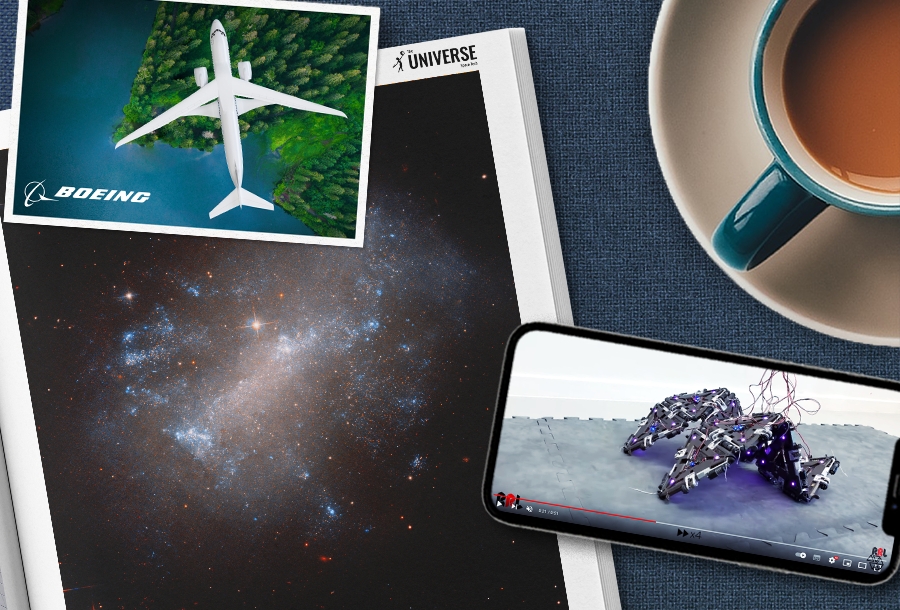Selection of the most interesting space news for the week: The United States had a fruitful week for innovation: NASA and Boeing made a breakthrough in environmentally friendly aviation; the US military planned tests of a small hypersonic drone, and we talk about what science lost together with the legendary Arecibo radio telescope.

“Inventing is a combination of brains and material. The more brains you use, the less material you need”
― Charles F. Kettering
First ever space pharmaceutical factory enters orbit
California startup Varda Space has announced the successful deployment of the W-Series 1 satellite. It represents the first space pharmaceutical factory that will manufacture drugs in microgravity. According to experts, in zero gravity conditions, there are no convection currents in the liquid, because there is no “top” to which heat could rise. As a result, the particles in the liquid do not form lumps and do not rise to the surface or sink to the bottom, as it happens on Earth. This makes it possible to produce drugs in crystal form with extreme precision, which can improve their effectiveness, availability and shelf life, as well as create new drugs.
Considering how much modern drugs cost, successful orbital production can bring very good money. As one example, Varda Space cites the drug for the treatment of leukemia Blincyto, which costs 114.3 billion US dollars per kilogram. Or the mRNA at the heart of Pfizer’s COVID-19 vaccine. Two gallons of this drug is equal to all the doses that Pfizer has manufactured to date. They brought the company more than USD 75 billion. Being stacked in stacks of hundred-dollar bills, they would have covered 82% of the way to space (if you count it from the 100 km mark).
NASA and Boeing present the X-66A aircraft: a breakthrough in environmentally friendly aviation
NASA’s newest experimental X-plane has finally received a name. The US Air Force named the next model X-66A. It was developed in collaboration with Boeing as part of a NASA project called Sustainable Flight Demonstrator. The X-66A became the first aircraft in the experimental X-plane series, created in such a way as to completely get rid of greenhouse gas emissions. The NASA press release states that the X-66A can serve as the basis for a new generation of environmentally friendly single-engine aircraft used in passenger aviation. Now this type of aircraft is responsible for half of greenhouse gas emissions worldwide. Therefore, the ecological version of the X-66A can significantly affect the reduction of greenhouse gas emissions.
Mori3 transformer robot to help astronauts colonize Mars
The research team of the Federal Polytechnic School of Lausanne (EPFL) in Switzerland is actively working on the creation of a robot that will be able to help astronauts during interplanetary missions, in particular on Mars. The innovative transformer robot called Mori3 is able to change its shape, size and functionality, turning from flat 2D triangles into any three-dimensional object. According to Paik, the Mori3 is great for space missions because it can be customized to different shapes according to the desired task. Although at the beginning the team plans to use it for external repairs and communication, it can be adapted to new tasks that will arise during the missions. It is also important that the robot can be kept in a horizontal position, which saves space during a long mission with the crew.
ESA tests 7 out of 10 science instruments of the JUICE mission
ESA specialists have successfully tested the operability of 7 out of 10 science instruments of the JUICE spacecraft. This was reported by the mission support group in response to a request from The Universe Space Tech editorial office.
The instrument commissioning phase is ongoing, but so far 7/10 science instruments are checked following launch ????
— ESA’s Juice mission (@ESA_JUICE) June 12, 2023
The JUICE spacecraft was launched on April 14, 2023. The purpose of its mission is Europa, Callisto and Ganymede — the three largest icy moons of Jupiter, under the surfaces of which huge oceans are hidden. JUICE will study these worlds, which will allow scientists to conduct a basic assessment of their potential viability.
Scientists transmit energy from space to Earth for the first time
A team of researchers from the California Institute of Technology reported on the successful testing of a prototype of a space solar power plant. It transmitted energy from space to Earth wirelessly. The experiment was conducted using the SSPD-1 demonstrator satellite. The 50-kilogram vehicle was launched in January 2023. After entering orbit, it deployed experimental solar electricity panels designed to collect solar energy.
The transfer of the collected energy was carried out by the MAPLE device (Microwave Array for Power-transfer Low-orbit Experiment). It converts it into microwave radiation, which is then transmitted via a phased antenna to a receiver located on the Earth. Then it is converted into an electric current.
Photo of the week

The Hubble mission support team has published a new image of the space telescope. It shows the galaxy NGC 7292, which is located at a distance of about 44 million light-years from Earth in the direction of the constellation Pegasus. Hubble’s photo demonstrates that it has a “disheveled” look. NGC 7292 does not have a characteristic spiral structure, so it is classified as an irregular galaxy. At the same time, it is interesting to note that its core is elongated into a distinct band. The presence of such a structure in the center is a characteristic feature of many spiral galaxies.
Interesting figure — over 8600 km/h

Next summer, the United States plans to conduct a test flight of the Dart AE aircraft. It will be a small hypersonic drone that will accelerate to a speed seven times faster than sound. Its length will reach only 9 m, and its weight will be 300 kg. At the same time, its jet engine will be able to accelerate this drone to a speed of Mach 7, that is, seven times faster than sound. In real numbers, it will be more than 8,600 km/h.
Something to read on the weekend

In early June, American astronomers unveiled plans for the construction of the next-generation radio telescope, which could partially replace the legendary Arecibo Observatory which collapsed on December 1, 2020. In this article, we explore the key discoveries made at Arecibo and why it held a special place in modern science.
Follow us on Twitter to get the most interesting space news in time
https://twitter.com/ust_magazine

